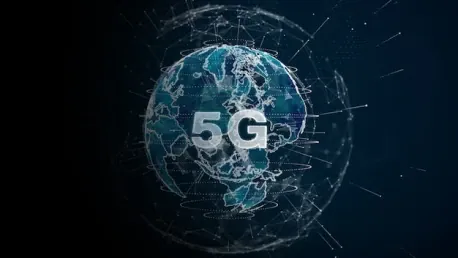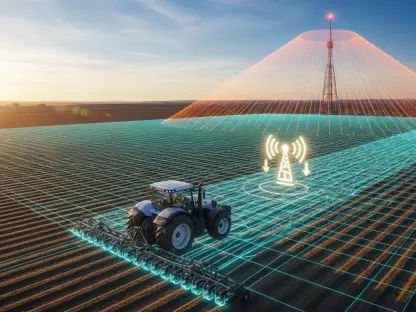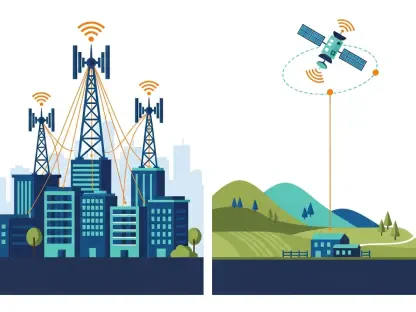Global 5G adoption has accelerated at a remarkable pace, significantly outpacing the expansion of previous wireless generations, such as 4G LTE. A recent study by 5G Americas, utilizing data from market research firm Omdia, has highlighted a historic milestone with forecasts projecting that 5G connections will reach an impressive 2.25 billion by the end of 2025. This rapid integration into the global mobile ecosystem demonstrates 5G’s swift adoption, growing four times faster than 4G LTE did in a comparable timeframe. This news underscores the transformative potential of 5G technology as it continues to revolutionize connectivity worldwide.
One of the key findings from the research is that by the end of 2025, there will be 1.5 wireless connections per person globally, a noticeable increase from one connection per person in 2014. The momentum of 5G adoption shows no signs of slowing down, with forecasts predicting that 5G connections will rise to an astonishing 8.3 billion by 2029. This will account for 59% of all global wireless technologies. Additionally, the Internet of Things (IoT) sector has experienced unprecedented growth, adding 438 million new connections in 2025, resulting in a global total of 3.6 billion IoT connections.
North America’s Leadership in 5G Deployment
North America has emerged as a regional leader in 5G deployment, attaining parity between the number of commercial 5G and 4G LTE networks. This leadership position can be attributed to strong industry investment, collaborative innovation, and a favorable regulatory environment that supports advanced applications in sectors such as industrial automation, telehealth, smart infrastructure, and AI-powered connectivity. By March 2025, North America boasted 18 commercial 5G networks and 18 LTE networks, a testament to the region’s robust network deployment capabilities and its commitment to advancing wireless technologies.
In addition to the number of networks, North America’s rapid 5G growth distinguishes the region as a benchmark for global adoption. As noted by Viet Nguyen, president of 5G Americas, achieving 2.25 billion 5G connections demonstrates how quickly this technology is revolutionizing connectivity. Nguyen emphasized North America’s critical role in shaping future advancements in wireless technology. Omdia principal analyst Kristin Paulin echoed these sentiments, pointing out that North America’s rapid 5G growth outpaces previous generations, setting new standards for worldwide adoption. This progress underscores the impact of deeply ingrained investment and policy support in driving forward the region’s technological capabilities.
Global 5G Network Expansion
The study also revealed that by the end of 2024, there will be 354 commercial 5G networks worldwide. Europe closely followed North America’s lead, with its 5G deployments representing 72% of its LTE networks. The rapid integration of 5G technology across Europe shows the region’s commitment to advancing its digital infrastructure and enhancing connectivity. Meanwhile, Latin America and the Caribbean reported significant growth in 5G connections, doubling their figures to 76 million by the end of 2024. This expansion occurred while these regions maintained a strong 4G LTE user base of 593 million, reflecting nearly three-quarters of all wireless connections in the area.
The global momentum of 5G technology adoption is further exemplified by the diverse range of countries and regions that have embraced this next-generation connectivity. The Middle East, Africa, and Asia-Pacific regions have also shown considerable advancements in their 5G deployments. These regions are experiencing both commercial and infrastructural growth, spurred by investments in 5G and related technologies. The consistent theme from this research highlights the rapid growth and transformative potential of 5G technology globally, reflecting the technology’s wide-reaching impact on various sectors and industries worldwide.
The Future of 5G and IoT Connectivity
The forecasts and current data trends indicate that the future of 5G is bright, with its integration into the global mobile ecosystem advancing at an unparalleled pace. The combined growth of 5G and IoT technologies will redefine how industries, businesses, and individuals connect and communicate. As advanced applications in areas such as smart cities, autonomous vehicles, and remote healthcare become more prevalent, the demand for high-speed, reliable 5G connectivity will continue to soar.
One notable aspect of the future landscape is the role of emerging technologies such as AI, edge computing, and machine learning, which will further enhance the capabilities and efficiency of 5G networks. These technologies are expected to drive innovation and create new opportunities in various sectors, ensuring that 5G remains at the forefront of technological advancement. As 5G networks expand and evolve, they will contribute to the development of more sophisticated IoT ecosystems, enabling seamless integration and interoperability across multiple devices and platforms.
Key Takeaways and Future Considerations
Global 5G adoption has surged rapidly, far outstripping the growth of previous wireless technologies like 4G LTE. According to 5G Americas, leveraging data from market research firm Omdia, it’s projected that 5G connections will hit a remarkable 2.25 billion by the close of 2025. This swift integration showcases 5G’s fast growth, which is happening four times faster than 4G LTE did in a similar period. The developments underline the transformative impact of 5G technology as it continues to revolutionize connectivity globally.
Research findings indicate that by the end of 2025, the average number of wireless connections per person worldwide will be 1.5, up from one per person in 2014. The pace of 5G adoption isn’t slowing, with predictions that 5G connections will soar to a staggering 8.3 billion by 2029. This represents 59% of all global wireless technologies. Moreover, the Internet of Things (IoT) sector has seen phenomenal growth, adding 438 million new connections in 2025 alone, culminating in a global total of 3.6 billion IoT connections.









